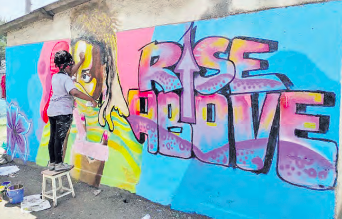
For eight years, Ninah Tanya has been drawing and painting Grevy’s zebras, the largest of the species and known for their close narrow stripes and ‘Mickey Mouse’ ears.
International Zebra Day was observed on January 31, in an effort to raise awareness of the need to protect all species of the regal striped beasts both the common plains zebra and the Grevy’s.
Ninah Tanya, who is 26, is not only attracted by the uniqueness of each Grevy’s zebra, but also by the realisation that the ‘imperial zebras’ are an endangered species, largely because of hunting for their beautiful hides and for traditional East Asian medicines.
In 1882, the Abyssinian Emperor thought the zebra so majestic that he gave one to French President Jules Grévy ( 1879-1887 ), hence the reference to the ‘imperial zebra’.
The Grevy’s zebra risks becoming extinct according to the International Union for Conservation of Nature. Only about 3,000 Grevy’s are left in the wild, particularly in Northern Kenya and Southern Ethiopia.
Tanya, who is based in Nairobi, is on a mission to raise awareness about these zebras and through her murals, she has been documenting conservations efforts to save them.
She emphasises the Samburu women popularly referred to as the ‘Grevy’s Zebra Scouts’. The women, affiliated to the Grevy’s Zebra Trust (GZT), are on the forefront in the fight to keep them safe from predators, atop the list being poachers.
Like their close relative, the donkey, this particular zebra is hunted for its hide, sought both for its beauty and for production of gelatin for medicinal purposes.
The Grevy’s zebra is more closely related to the wild ass than the plains zebra. “As an artist, my work is deeply rooted in storytelling, culture, and conservation. Grevy’s zebra is more than just an iconic species — it’s a symbol of resilience, balance, and the delicate relationship between humans and nature,” Tanya told the Star.
“I have interacted with women such as Ngeeti Lempate, popularly known as Mama Grevy’s, who leads a team of 40 women in Samburu to ensure the animals are fed, their water is fresh and poison-free and their habitat is clean and safe.” They are also in charge of monitoring the zebras, which is essential to the census of the animals.
“What surprised me most was the women would deliberately grow grass to feed the animals during the dry season,” Tanya said.
“It was very interesting that their husbands were fully supportive, in fact, hailing them as heroines for their efforts in conservation. “Watching their dedication to a wild animal made me realise the world will never know of these heroines, hence, my decision to draw murals with the women across various international walls,” Tanya said.
Her art is being showcased at the first East African mural festival from February 3 to 17 in Fumba, Zanzibar.
“This isn’t just about sharing my experience in preserving a species hunted by both humans and lions,” Tanya said.
“It is also about highlighting the vital role art plays in conservation. Artists have a unique power to shape these important debates and use their craft to protect the wild. And they should use it as often as possible.”
The festival, which includes street art, exhibitions and workshops, aims to create awareness about endangered species.
“Before I began working with zebras, I had no clue how their distinct features like their ears, noses and stripes could reveal so much about their species,” the artist said.
“I had so many light-bulb moments, and it was a ‘wow’ experience. It led me to understand how even the smallest efforts in raising awareness can spark a deeper connection to wildlife and inspire people to protect it.”
She uses her artwork to raise funds by cooperating with environmental organisations protecting the zebra.
“Partnering with organisations such as GZT has led to very tangible change project,” the artist-conservationist said.
“Funds raised re being channelled to a range of impactful initiatives, including scholarships for children and empowering women through capacity-building programmes.”
She said it is beautiful to witness the women zebra scouts gain the skills and confidence to support themselves and their communities.
Tanya said collective engagement, including habitat restoration, water restoration and general conservation are essential to fighting for nature and wildlife in general.
“As an artist, I see it as my responsibility to help raise awareness and it’s already making an impact,” she said.
“More and more artists are now exploring murals of endangered species, or simply showing a genuine interest in recognising the role art plays in conservation. “It is igniting a broader conversation about conservation, one that is growing and gaining momentum.”
Victoria Firth, an environmental mural artist and co-founder of the World Mural Movement, has collaborated with Tanya to raise awareness about zebras and partnered with her on the Zanzibar initiative. She strongly believes in “painting for change,” whereby artists use their work, particularly murals, to tell important stories.
In this case, the murals highlight campaigns on women’s rights and female empowerment, while also focusing on endangered species and the efforts to protect them.
“Including Kenyan artists like Ninah in this initiative is really about drawing attention to the Grevy’s zebras,” Firth said.
She hopes murals featuring “these incredible creatures” will be shown at the next festival, possibly in the UK at the end of this year, and in Côte d’Ivoire next year.
“This is even more exciting because we’re pairing the art with educational mentorship programmes, bringing something engaging and meaningful to the communities on the ground,” Firth said.
Additionally, we help artists in capacity-building, mentoring them in monetising their products, creating art portfolios, and using street art to communicate for change.

